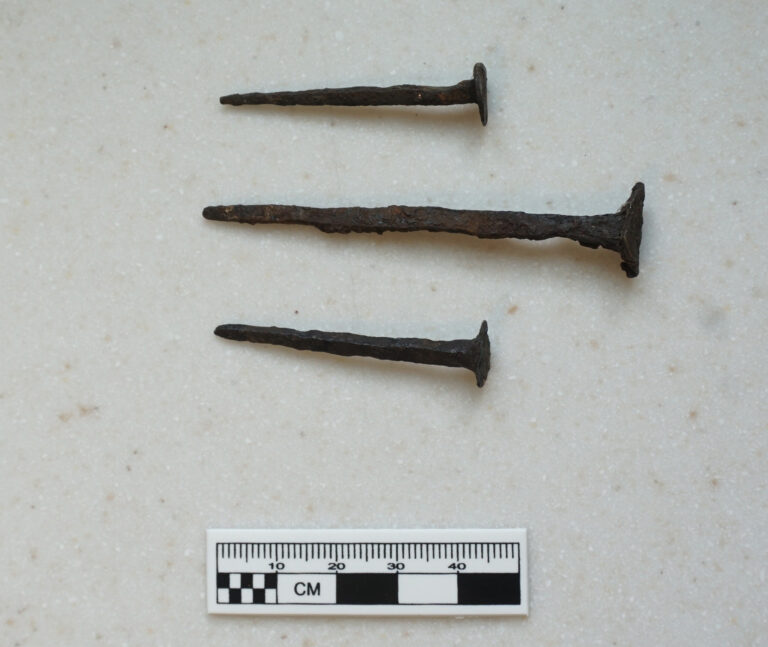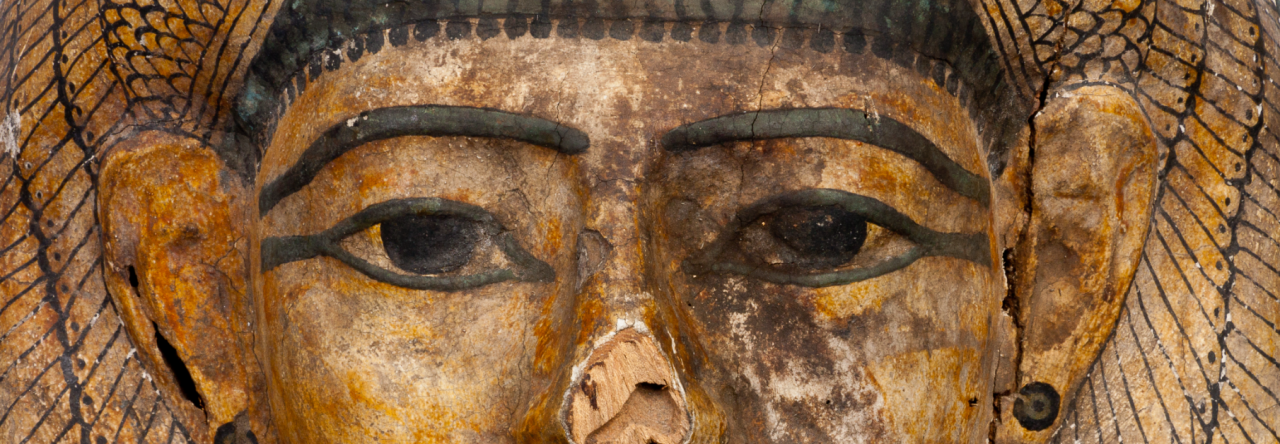
Three Nails
AWG0000.04.01
Roman, Romano-British
Roman Imperial, 1st Century CE
Material: Iron
Weight: The largest weights 7g, the other two weigh 3g each
Dimensions: The largest is 7.2 cm long, while the other two are 4.3 cm and 4.5 cm long. All are 0.1 cm wide.
Provenance: Said to be from Fort Inchtuthil, Scotland
Source/donor: Former student of the Classics department
Date of acquisition: Unknown
Other notes: The nails were once mounted on a terracotta frame modeled after a Roman shrine, as a tourist souvenir. According to the label on the back of the frame, the nails are coated in a “rust resistant substance.” There is a gold plated plaque on the mount that reads “ROMAN LEGION NAILS circa 2000 years old”
Research by: Julia Berutti, ‘23
Detailed description of form/shape:
One large nail and two medium-sized iron nails, with flat, circular, thin disk-shaped heads; square, tapered shanks; and diamond points
Comparanda:
For the general shape and size, see the J. Paul Getty Museum 78.AI.252, Penn Museum 61-24-1J, 61-24-1K,and 61-24-1L, and the Australia National University Classics Museum 2012.14, figures A2 and A3. All of these examples are said to be from the same nail hoard at Fort Inchtuthil.
Discussion:
These nails, likely dating from the 1st Century CE, tell a riveting story of Roman infrastructure and Rome’s influence in Great Britain. Though it is impossible to say where they came from with certainty, it is probable that these nails were discovered at Fort Inchtuthil in Scotland. From 1952 and 1965, the city of Edinburgh, along with private donors, funded an archeological excavation of the Roman fort, led by Sir Ian Richmond and J.K St. Joseph (Pitts and Joseph 1985, 49-50). During the excavation, the team found a heap of at least 875,428 nails, but the total number is likely well over 1 million, weighing multiple tons. The outer layer of the heap took the brunt of corrosion, forming a kind of crust that preserved the nails in the core from much rust and wear. The nails from this hoard were categorized into six types, with the most common being “small, disc-headed nails,” like two small nails here (Pitts and Joseph 1985, 112). Similar nails in the Getty Museum, Penn Museum, and the Australian National University (noted above) also fit this description. Thousands of the nails from the excavation were sold from 1961 to 1963 to fund the project, with each nail selling for 25 shillings, or about $33 today. Nails from this site are still being sold through online catalogs today (Budrovich 2020).
Inchtuthil was likely built around 83 CE, just north of modern Perth, Scotland (“Inchtuthil”, 2021). One study calculated that the fort would have taken 4.7 million man-hours to complete, or 587,500 eight-hour working days (Shirley 1996, 127). It also suggests that the builders would have required massive amounts of nails to complete the project, some 800,000 for roof shingles, 75,000 for tegulae specifically, and over 700,000 for wall exteriors (Shirley 1996, 118). The construction of this fort was a massive undertaking, requiring excessive access to raw materials and labor, but the Romans were well-equipped, as they were among the first to use hydraulic mining to extract metal ores from large rock structures. This gave them access to huge amounts of raw materials, such as iron (Wilson 2002, 17). Moreover, because of the uniformity of the nails found at Inchtuthil, both in terms of shape as well as carbon ratios within the metal, it is suggested that the Romans developed a system of quality control for nail production (Lang 2017, 858). The leading theory as to why these nails were found in a massive hoard was that the Roman soldiers purposely buried them to prevent their enemies from using them (Robertson 1970, 201).
Bibliography:
Budrovich, Nicole. “From Ancient Scotland to Online Auctions: A Tale of Roman Nails.” Getty Iris (blog), January 15, 2020. http://blogs.getty.edu/iris/from-ancient-scotland-to-online-auctions-a-tale-of-roman-nails/.
“Excavation Photograph Showing the Nails Removed from the Refuse Pit. | Canmore.” Accessed September 30, 2021. https://canmore.org.uk/collection/348665.
Mazis, Matasha. “Five Iron Nails from the Roman Hoard at Inchtuthil.” Accessed October 4, 2021. https://www.academia.edu/2637467/Five_iron_nails_from_the_Roman_hoard_at_Inchtuthil.
Pitts, Lynn, and J.K St. Joseph. Inchtuthil: The Roman Legionary Fortress. Britannia Monograph Series 6. 31 CORDO N SQUARE LONDON: The Society for the Promotion of Roman Studies , 1985. https://archaeologydataservice.ac.uk/archiveDS/archiveDownload?t=arch-3299-1/dissemination/brit_6/Britannia_Monograph_Series_No_6_Inchtuthil.pdf.
The J. Paul Getty in Los Angeles. “Group of Four Nails (Getty Museum).” Accessed September 30, 2021. https://www.getty.edu/art/collection/objects/8202/unknown-maker-group-of-four-nails-roman-1st-century-ad/.
Robertson, Anne. “Roman Finds from Non-Roman Sites in Scotland: More Roman ‘Drift’ in Caledonia.” Britannia 1 (1970): 198–226. https://doi.org/10.2307/525841.
School, Head of and admin.hal@anu.edu.au. “Five Roman Nails - 2012.14.” ANU School of Literature, Languages and Linguistics, March 11, 2020. https://slll.cass.anu.edu.au/classics-museum/catalogue/objects/five-roman-nails-201214
Shirley, Elizabeth A. M. “The Building of the Legionary Fortress at Inchtuthil.” Britannia 27 (1996): 111–28. https://doi.org/10.2307/527041.
Wilson, Andrew. “Machines, Power and the Ancient Economy.” The Journal of Roman Studies 92 (2002): 1–32. https://doi.org/10.2307/3184857.
